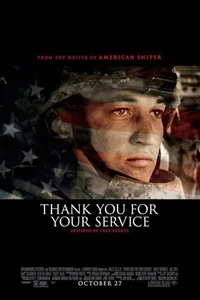“Thank You for Your Service” is an Iraq War movie but not a conventional one. Writer/director Jason Hall’s picture focuses on soldiers returning home and the adjustments, struggles and churn that present brand new challenges for them. The film is based upon David Finkel’s 2013 non-fiction book with the same title, and Miles Teller, Beulah Koale and Joe Cole star as vets who carry internal, cerebral scars from the war.
Jason stopped in the Valley on Oct. 12 and 13 and sat down with the Phoenix Film Festival for a group interview. This first time director – who also wrote “American Sniper” (2014) – talked about the importance of addressing soldiers’ experiences after combat, veterans’ reactions to his film and much more.
“Thank You for Your Service” arrives in theatres on Friday, Oct. 27.
Q: Two of three soldiers who come home, Adam (Miles Teller) and Solo (Beulah Koale), are real-life men, who you talked with prior to filming. In the movie, Adam has difficulty speaking about his Iraq experiences. He does not want to share with his wife, Saskia (Haley Bennett), and does not talk about it with his friends. Is this because he was a leader in Iraq, so he feels that he should show a silent strength back home?
JH: The challenge with this (movie) was making the story personal enough about Adam, but also making a story - through these guys and their decisions – that applied to every warrior who has come home (under similar) circumstances. (The military teaches) these guys to shoot at human targets, so they can shoot at humans and walk into the bullets (on the battlefield), when (one’s) primary instinct is to walk away. They teach them how to be fearless, and how to do things that normal humans just don’t have the capacity to do.
In doing that, they create this toughness and this shell that allow them to do it, and everything that comes (afterwards) about finding your way back to yourself is untaught. How you remove the shield that the warrior has been given in order to (step) into battle?
Taking away that shield is very hard.
So, for someone like Adam, it blew me away that (for) everything heroic that he has done in battle, he came back and revealed himself to David Finkel (the author of the book, “Thank You for Your Service”), allowed him into his life and watch what he was going through. Even (through) some of Adam’s resistance to tell stories or to hold on to certain things, his willingness to articulate, let this guy in and be vulnerable was as heroic as anything that he did in battle.
Q: Your film places more emphasis on what happens when a soldier comes home, as opposed to what happens in combat. Why do you think that is so important to talk about, especially in film?
JH: I think (knowing) the consequences of war are tremendously important to a society, especially one that distances (itself) from the aftermath of war and the consequences (for) its warriors. In my mind, and what I’ve seen, these guys are honorable, young men and women, who are making decisions to serve their country. It’s beholden upon us - not just the government, but the citizens – to make sure that we are making the right decisions, and we are electing the right people who put us into conflicts equally as honorable as the men (and women) we are sending over there.
For all the war films that we make, we haven’t made a ton about (soldiers) coming home. Cinema holds a big responsibility, in that it’s able to shift people’s perception. So, it’s also beholden upon us to tell the right story. Tell the true story and not just half the story that sells a lot of tickets.
Q: Do you see “Thank You for Your Service” as a response to “American Sniper” or a spiritual duo?
JH: I call it spiritual sequel, I think. It stands as its own film (too). (In “American Sniper”), these guys go away and fight a very different war. They came from very different places and are very different people from who these guys in “Thank You for Your Service” are.
It was challenging for me. Early on, I thought, “I already know this war. I’ll just step right in and tell this story.”
That wasn’t the case.
Because of the selective process of special forces, there’s a different way that the soldiers in “American Sniper” deal with the traumatic effects of war. In the Navy SEALs selection process, they weed out everybody, and it’s not a physical weeding out. It’s a psychological one. It’s not Olympic athletes who go to “Hell Week” and make it. (They are) guys who have armors, who have tough minds, who (get) up at 5 o’clock in the morning, who know hard labor. (They are) farmers, wrestlers and blue-collar kids that just have a toughness about them. That mental toughness translates to battle, and they are less susceptible to some of the things that others suffer because of that mental toughness. They (are) able to compartmentalize pain (and) suffering, so it’s a psychological weeding out of those who are not able to process mental anguish in a way.
These guys, on the other hand, when you start talking to them, they had very little training. There was very little time to prepare them. You are dealing with kids, and they don’t have the experience, they don’t have the training, and they don’t (go through a) weeding out process. They are just (looking) for an opportunity.
Adam comes from a nice family. He comes from a well-off family. For a lot of these guys, (joining the military) is their best opportunity. Becoming a warrior is their best opportunity. Adam Schumann fell in love with a girl. He wanted a house (with) a picket fence, and he didn’t want go fracking in North Dakota. He could’ve done fracking work or join the military and serve his country. That seemed much more honorable to him. So, it’s a different story than special forces. This is really the working-warrior class. It’s the blue-collar soldier that we send off to war, and I wanted to make a film with social realism about these warriors’ struggles when they come home.
Q: What has been the reaction from Adam Schumann and vets who have seen “Thank You for Your Service”?
JH: It’s been terrific. The first time I showed Adam, we got him some popcorn and a Coke, and he said that he didn’t touch the popcorn (and) Coke the whole time and basically cried for an hour and 45 minutes. He (also) laughed and had these experiences of beauty. Afterwards, I gave the guy a hug, and he said that (the movie) was beautiful.
The most common response that I have (received) from veterans is: “Somebody finally told our story.”
Q: One of the movie’s themes is: the real world that these men come back to is not the one that they (once) knew. Something has changed, but their spouses might assume that home is exactly the same. Does that frequently occur?
JH: I think spouses (sometimes) expect the (people) that they send off, return to them the same. They expect that person to step into the same role that they left. They are not expecting (that they) come back changed and parts of them are unknown now. The trick is (to) structure (the film), so the audience is also in that unknown part as well.
You want (the audience) to be with Adam and the guys, but also step back and say, “Who are they talking about? Who are these names that they are bantering around? I don’t know what happened. This is unclear.”
And (the movie) is intentionally unclear, because that is what (a) family experiences. A family experiences the mystery, (tries) to unwrap the newness of this person and get to the bottom of this story. (The returning warrior) had relationships and extraordinary experiences that (family members) don’t understand or even know about.
I wanted to structure the film, so the audience felt that too.
Q: You started out acting and made the transition to screenwriting. Now you are directing. Would you say that it has been a very natural transition for you?
JH: Yea, I think they all happen organically. There wasn’t a real plan there. I tried to go to film school early on and (was) certain that I wanted to make (movies). So, I just kept kicking on doors, until somebody let me do it.
Q: Working with Clint Eastwood on “American Sniper”, did you learn anything from him as a director?
JH: I think you learn a lot from anybody who is a master like that, and certainly, there is an ease and fluidity that Clint works that is intoxicating. I don’t have (the) same persona as Clint. I’m very anal. So, God bless him, but I am not that kind of filmmaker.
(In my movie), I wanted to find an architecture in the houses that was similar to the (ones) that they lived in. I made sure that we had 200 actual veterans sitting in the VA, because I know that veterans recognize veterans. I imported two tons of trash into Morocco, because I haven’t seen an Iraq war film that had enough trash in it. “The Hurt Locker” (2008) was maybe an exception.
So, I guess I learned a lot from Clint and nothing at all. Maybe it just takes 100 films to get that ease and calm.
Jeff – a member of the Phoenix Critics Circle – has penned film reviews since 2008 and graduated from ASU’s Walter Cronkite School of Journalism. Follow Jeff and the Phoenix Film Festival on Twitter @MitchFilmCritic and @PhoenixFilmFest, respectively.


















































